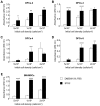Characterization of human dental pulp cells grown in chemically defined serum-free medium
- PMID: 29556382
- PMCID: PMC5844140
- DOI: 10.3892/br.2018.1066
Characterization of human dental pulp cells grown in chemically defined serum-free medium
Abstract
Dental pulp cells (DPCs) are promising candidates for use as transplantable cells in regenerative medicine. However, ex vivo expansion of these cells typically requires culture media containing fetal bovine serum, which may cause infection and immunological reaction following transplantation. In addition, the proliferation and differentiation of DPCs markedly depend upon serum batches. Therefore, the present study examined whether DPCs could be expanded under serum-free conditions. DPCs obtained from four donors were identified to proliferate actively in the serum-free medium, STK2, when compared with those cells in control medium (Dulbecco's modified Eagle's medium containing 10% serum). The high proliferative potential with STK2 was maintained through multiple successive culture passages. DNA microarray analyses demonstrated that the gene expression profile of DPCs grown in STK2 was similar to that of cells grown in the control medium; however, a number of genes related to cell proliferation, including placental growth factor and inhibin-βE, were upregulated in the STK2 cultures. Following induction of osteogenesis, DPCs grown in STK2 induced alkaline phosphatase activity and calcification at higher levels compared with the control medium cultures, indicating maintenance of differentiation potential in STK2. This serum-free culture system with DPCs may have applications in further experimental studies and as a clinical strategy in regenerative medicine.
Keywords: cell proliferation; dental pulp cells; gene expression; osteogenesis; regenerative medicine.
Figures





References
-
- Iohara K, Zheng L, Ito M, Tomokiyo A, Matsushita K, Nakashima M. Side population cells isolated from porcine dental pulp tissue with self-renewal and multipotency for dentinogenesis, chondrogenesis, adipogenesis, and neurogenesis. Stem Cells. 2006;24:2493–2503. doi: 10.1634/stemcells.2006-0161. - DOI - PubMed
LinkOut - more resources
Full Text Sources
Other Literature Sources
